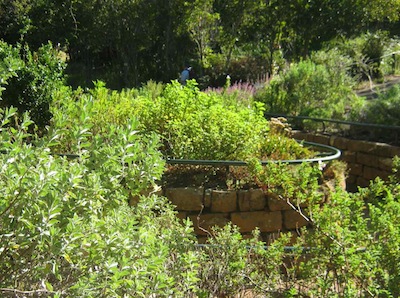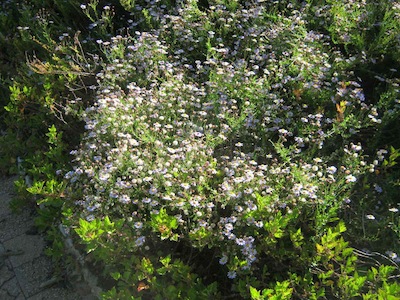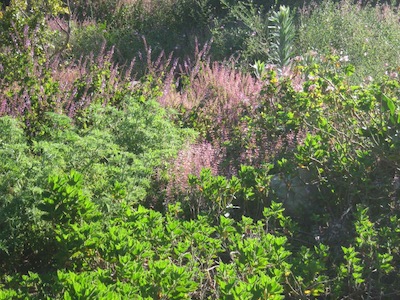Dear Reader, in this age of AI created content, please support with your goodwill someone who works harder to provide the human-made. Sign up at the top of the lefthand column or bottom of this page. You will receive my hand illustrated monthly newsletter RESTORE NATURE and access to the biodiversity garden design course as I write...and nothing else, I respect your time. I am also removing the advertizing as best I can as its become intrusive inappropriate and pays me nothing.
how to plant a dry water-wise garden
This article explains how to plant with the right positioning for a plant's above and below ground needs, and conserve water when you transplant. The last article dealt with water-wise planting arrangements and lawn replacements. The next article after this will be about mulching.
How to plant a dry garden and conserve water...know your soil
Soil nutrients
Before you choose the actual plant species to plant, consider your soil's nutrient status. Different Mediterranean climates may have similarities but their soils and geology are of course much more diverse. Choose plants for your soil rather than seeking to change your soil with additives and irrigation. The soil nutrients, soil type, drainage, subsoil water, rocks and walls and sunshine will help you decide how to plant and what to plant.
pH tests are relatively inexpensive and can be bought at nurseries and pet shops. You can do a soil-type test in a bottle of water. I described this previously and here is a pin at the bottom of the page. For the rest, operate according to your budget. Multi-mineral soil tests are expensive, for me that is a few thousand rands, or hundreds of Euros or dollars. A chat with neighbours who are farmers or keen gardeners may clear up questions on soil deficiencies in your area. Above all, do not add artificial fertilizers in dry gardens.
 a cool root run next to a rock, bark mulch lowers nitrogen, but this desert plant yellows at rainy Kirstenbosch
a cool root run next to a rock, bark mulch lowers nitrogen, but this desert plant yellows at rainy KirstenboschAccording to Gildemeister (1995:74) in Mediterranean Gardening: A Waterwise Approach, too much nitrogen encourages spindly growth and bulb decay. This is doubly true for Cape plants. Indeed Van Jaarsveld (2010) Waterwise Gardening in South Africa and Namibia advocates avoiding synthetic fertilizers in order to be water-wise. The alkaline calcareous soils of the Riviera also increase the soil concentrations of Potassium and Phosphorous and tax plants, so do not apply these minerals to your soil when growing South Africa plants which come from very leached soils. The connection with water saving is that the closer you meet the nutrient needs of plants, and that context informs you what and how to plant, the less water they require.
 Aloe arboresens tolerates shade but loves heat and light
Aloe arboresens tolerates shade but loves heat and lightHow to plant a water-wise garden with careful positioning
Drought tolerant plants require careful positioning for above and below ground conditions according to Gildemeister (1995:62). The more you exploit the garden microclimates the better you will meet their needs.
 Most of our herbs like to bask in the sun
Most of our herbs like to bask in the sunAbove ground
Inform yourself on the plant’s demands for light. If they need sunshine but not intense heat, this will help you decide how to plant them. This demand is best fulfilled by planting under tall moving shade supplied by big trees with high canopies and bare trunks, like palms or umbrella pines, or trees which have been shaped to produce high shade.
Afternoon sun is the most stressful sunshine, so plant sensitive plants to the east of barriers, or on south facing slopes and walls.
Reserve the hottest locations for Cape plants.
Use twig or branch wigwams to shade small new plantings. It is interesting that Gildemeister mentions wigwams. They are very effective during transplanting, as I learned when working for a master vegetable garden designer.
 plenty of sun, but wettish feet
plenty of sun, but wettish feetBelow ground
The soil depth should also tell you how to plant and which plants to choose. Match the soil depth to the plant’s preferred form of root structure. On rock or in shallow soil choose superficial rooters (Gildemeister 1995:64).
Many European Mediterranean plants survive with less stress if they have a cool root run, near a rock, or a wall.
Soil moisture is preserved in places protected from drying out like southern slopes, plant shaded places and hollows.
The underground parts of South African plants like a good bake during the dormant season, Gildemeister says, so make sure they don’t get damp during summer. I must add this is in the context of growing our plants in Europe. My mother found that many of our geophytes have mechanisms to protect themselves from too much heat, actually, which they may often experience in our climate. They may have retractable bulbs which burrow deeper during summer.
 two Pelargoniums in the foreground, on a low terrace
two Pelargoniums in the foreground, on a low terraceAlways supply adequate drainage for drought tolerant plants that require it. Poor drainage shortens the life even of European Mediterranean plants like bay. Plant cushion plants or plants that love good drainage on terrace walls, and trees at the back of terraces where there are cool root runs.
Where water gathers plant those which like soggy winter roots.
Mediterranean plants grow roots in spring or autumn, therefore plant with the first winter rains. Also plant Mediterranean bulbs in autumn, for later summer baking. Spring is for planting out tropicals, be careful of their winter dormancy, which can cause roots to rot if the area is wet in winter.
 a massive wild banana in the wettish zone
a massive wild banana in the wettish zoneGeneral transplanting tips
You can save water by transplanting correctly because if you reduce root trauma you don’t need to overwater plants for them to survive while they are taking. Gildemeister (1995:64) advocates always digging a generous planting hole, and Van Jaarsveld (2010) a hole twice the size of the container.
 aromatics generally like the good drainage in raised beds
aromatics generally like the good drainage in raised bedsFree root planting
My mother during her years of forest conservation activism, and the Parks Board with whom she had contact, found that the smallest possible hole that can accommodate the root ball actually works better. It is a new trend in tree planting called 'free root planting' and was featured some years back in the British Horticultural Journal. It is not well known and a google search will not produce hits. It involves minimal disturbance of the roots and minimal breakage. Rocks are packed around the seedling and these conserve water in the soil around the roots both through cooling the soil, and through their weight and the increased supply of accessible water this creates.
 These succulents grow on a dry wall terrace
These succulents grow on a dry wall terracePrepare the new hole first
Gildemeister suggests that one water
in the holes before planting, which also allows one to assess the soil
drainage. If after an hour the soil is not fully drained, choose plants which
tolerate wet feet. I’ve found that this is a good idea. I water plants and the
soil they are going into thoroughly, transplant and firm the soil very very
gently to reduce root hair breakage and then don’t water after planting for 24
hours.
Dig the new hole before digging up the plant to be transplanted and
exposing it to dessication. To reduce transpiration from the leaves during the
shock phase when many root hairs are lost, shorten the branches by a third, and
conserve fine roots by being gentle. Gildemeister recommends firming the soil
around the plant and watering it in to make sure of root breakage.
You can foliar feed if roots have suffered. Gildemeister gives a good tip for wind resistance. Place the strongest root in direction of prevailing wind and stake young or top heavy plants in windy places. Plants can take one to two years to establish.
 in the afternoon shade supplied by a thin Vergilia
in the afternoon shade supplied by a thin Vergilia------
home page for links to all kinds of practical information on natural gardening and food growing
------
natural garden design, its benefits
------
Restore Nature Newsletter
I've been writing for four years now and I would love to hear from you
Please let me know if you have any questions, comments or stories to share on gardening, permaculture, regenerative agriculture, food forests, natural gardening, do nothing gardening, observations about pests and diseases, foraging, dealing with and using weeds constructively, composting and going offgrid.
You’re a home gardener ! Share your experiences and questions !
We all know about home gardening. Tell us about your successes, challenges and ask about issues that bother you. You may have the luxury of a back garden, but there are other ways we learn. Few people age without growing something or buying vegetables during their lives ! It is absolutely guaranteed that you have learned things which can help others on their gardening journey.
We invite you to share your stories, ask questions, because if a thing has bothered you it will bother others too. Someone may have a solution ! No question is too small. There is learning for everyone involved, for you, for me (yes, I learn from every question), for us all. Exciting stuff !
We are starting on a new journey. Every week we will profile your letters ! The best stories and questions we receive.
SEARCH
Order the Kindle E-book for the SPECIAL PRICE of only
Prices valid till 30.09.2023
Recent Articles
-
garden for life is a blog about saving the earth one garden at a time
Apr 18, 25 01:18 PM
The garden for life blog has short articles on gardening for biodiversity with native plants and regenerating soil for climate amelioration and nutritious food -
Cape Flats Sand Fynbos, Cape Town's most endangered native vegetation!
Apr 18, 25 10:36 AM
Cape Flats Sand Fynbos, a vegetation type found in the super diverse Cape Fynbos region is threatened by Cape Town's urban development and invasive alien plants -
Geography Research Task
Jan 31, 25 11:37 PM
To whom it may concern My name is Tanyaradzwa Madziwa and I am a matric student at Springfield Convent School. As part of our geography syllabus for this
"How to start a profitable worm business on a shoestring budget
Order a printed copy from "Amazon" at the SPECIAL PRICE of only
or a digital version from the "Kindle" store at the SPECIAL PRICE of only
Prices valid till 30.09.2023








